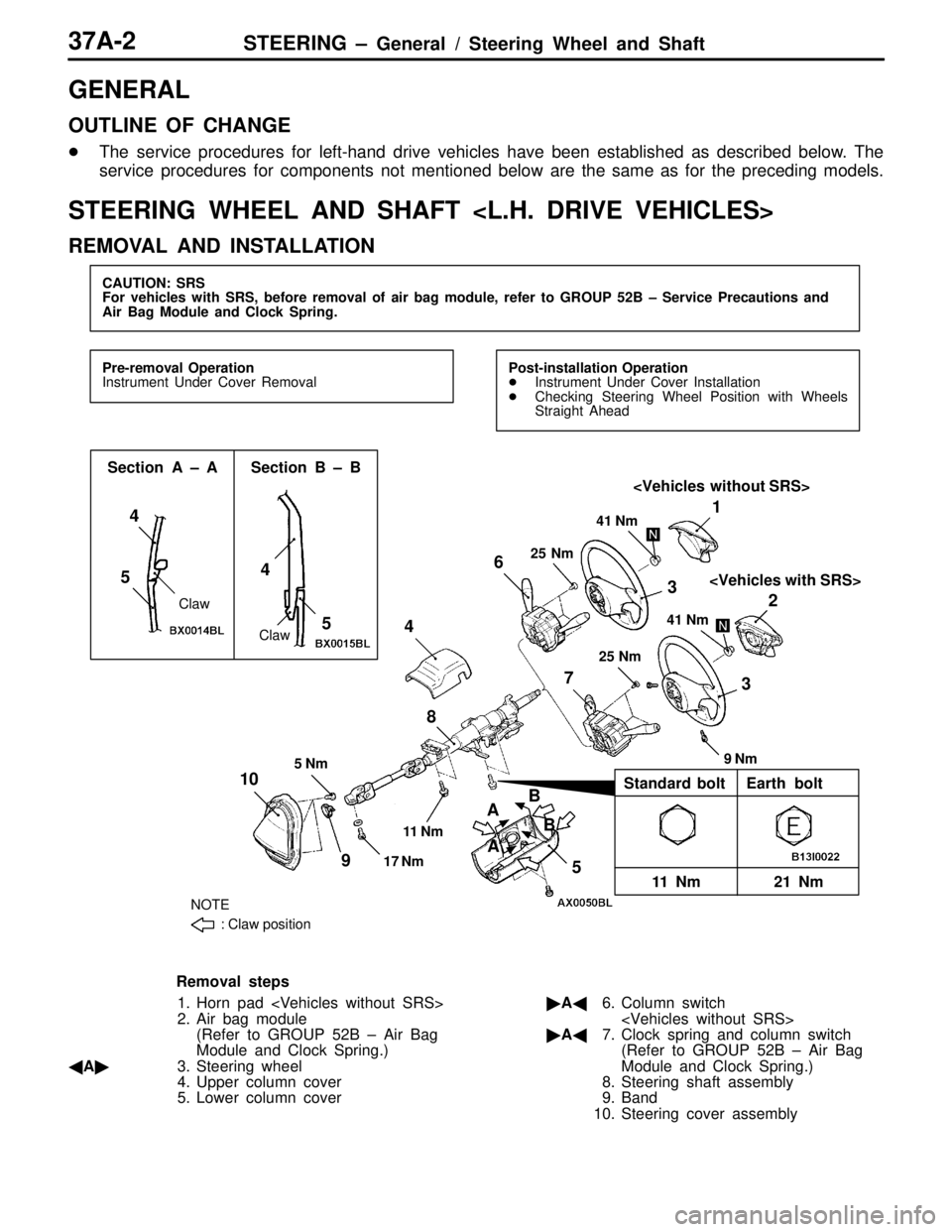Page 222 of 558
REAR AXLE – Troubleshooting 27-26
Item No.Normal value Checking requirements Check item
46Steer sensor (ST-N)Steering wheel position
Ignition switch: ON
Neutral positionON
Ignition switch: ON
90 deg. turned
from neutral
positionOFF
47Steer sensor (ST-1)Steering wheel position: Turn slowly counterclock-
wise.
Ignition switch: ONON and OFF are
indicated alternate-
ly.
48Steer sensor (ST-2)Steering wheel position: Turn slowly clockwise.
Ignition switch: ONON and OFF are
indicated alternate-
ly.
50Stop lamp switchAccelerator pedal position
Ignition switch: ON
DepressedON
Ignition switch: ON
ReleasedOFF
56Pressure switchForced activation No.13 or
No.14 is being executed.Electric pump in
operationLow
Electric pump
not in operationHigh
59ABS monitorABS monitorON
ABS not in operationOFF
Page 227 of 558

REAR AXLE – On-vehicle Service 27-31
ON-VEHICLE SERVICE
REAR AXLE TOTAL BACKLASH CHECK
If the drive system roars or the vehicle vibrates, use the
following procedure to measure total backlash in the rear
axle. Based on the measurement taken, determine whether
the differential carrier assembly needs to be removed or not.
1. Place the shift lever in the neutral position and operate
the parking brake.
2. Turn the propeller shaft fully clockwise and make an
alignment mark on the companion flange dust cover and
gear carrier.
3. Turn the propeller shaft fully counterclockwise and
measure the deviation between the alignment marks.
Limit: 5 mm
4. If the backlash exceeds the limit, replace the differential
carrier assembly.
GEAR OIL LEVEL CHECK
DIFFERENTIAL
1. Remove the filler plug.
2. Check that the gear oil level is within the specified range
from the bottom end of the filler plug hole.
Standard value (A): 6 mm
3. If the gear oil level exceeds the standard value, add the
specified gear oil up to the bottom end of the filler plug
hole.
Specified gear oil:
Hypoid gear oil API classification GL-5 or higher
SAE viscosity Number 90, 80W.
NOTE
10�C or more: #90, less than 10�C: #80
4. Fit the filler plug and tighten it to the specified torque.
Alignment marks
Filler plug
49 Nm
Gear oil
Upper
limit
Lower
limit
Page 230 of 558

REAR AXLE – On-vehicle Service REAR AXLE – On-vehicle Service 27-34
BLEEDING
1. Lift up the vehicle.
2. Connect the MUT-II to the 16-pin diagnosis connector.
Caution
Before connecting or disconnecting the MUT-II,
always turn off the ignition switch.
3. Turn on the ignition switch.
4. Operate the MUT-II (Item No.10) to activate the hydraulic
unit forcibly.
NOTE
(1) The forced activation (air bleeding mode) will be
automatically canceled after 5 minutes operation. It
can also be canceled forcibly by operating the clear
key on the MUT-II.
(2) While this function is being disabled by the fail-safe
function, the forced activation of the hydraulic unit
can not be executed.
5. Remove the cap of the left bleeder screw on the torque
transfer differential and connect a vinyl hose.
6. Gradually turn the steering wheel clockwise from the
straight-ahead position. At this time, loosen the left bleeder
screw and check that fluid is discharged with air.
7. After air has been completely discharged, tighten the
bleeder screw.
Caution
While the system is being bled of air, add fluid as
necessary to ensure that it is left in the oil reservoir
during the entire procedure.
8. Repeat steps (6) and (7) two to three times until no air
bubbles are recognized in the fluid that comes out. Then,
tighten the bleeder screw to the specified torque.
Tightening torque: 9 Nm
9. Perform steps (5) through (8) for the right bleeder screw.
Note, however, that the steering wheel should be turned
counterclockwise.
10. After the system has been completely bled of air, check
for the fluid level. (Refer to P.27-33.)
Caution
If the system is not completely bled of air, the hydraulic
unit could generate noise, degrading pump durability.
AYC OPERATION CHECK
1. Lift up the vehicle.
2. Connect the MUT-II to the 16-pin diagnosis connector.
Caution
Before connecting or disconnecting the MUT-II, always
turn off the ignition switch.
3. Start the engine.
4. Operate the MUT-II with the transmission in 2nd or a
higher gear and check to ensure that the vehicle speed
is higher than 10 km/h using the Data List (Item 10).
Bleeder
screws Vinyl hose
Page 237 of 558
REAR AXLE – Sensor Relay 27-41
SENSOR RELAY
REMOVAL AND INSTALLATION
Caution: SRS
For vehicles with SRS, before removal of air bag module and clock spring, refer to GROUP 52B
– Service Precautions and Air Bag Module and Clock Spring.
12
3
4
Steer sensor removal steps
�Steering wheel and column cover
�A�1. Steer sensorAcceleration sensor and AYC relay
removal
2. Longitudinal acceleration sensor
3. Lateral acceleration sensor
4. AYC relay
NOTE
For the wheel speed sensor, refer to GROUP 35B.
REMOVAL SERVICE POINT
�A�STEER SENSOR REMOVAL
Remove the steer sensor from the column switch.
Caution
(1) A photocoupler is used as the steer sensor. Use care
not to allow dust or grease to be on the sensor.
(2) Do not bend or dirty with grease the slit plate on
the column switch side.Slit plate
Steer sensor
Page 251 of 558

37A-1
STEERING
CONTENTS
GENERAL 2. . . . . . . . . . . . . . . . . . . . . . . . . . . . . . .
Outline of Change 2. . . . . . . . . . . . . . . . . . . . . . . . .
STEERING WHEEL AND SHAFT* 2. . . . . . . .
POWER STEERING GEAR BOX* 5. . . . . . . . .
WARNINGS REGARDING SERVICING OF SUPPLEMENTAL RESTRAINT SYSTEM (SRS) EQUIPPED VEHICLES
WARNING!
(1) Improper service or maintenance of any component of the SRS, or any SRS-related component, can lead to personal
injury or death to service personnel (from inadvertent firing of the air bag) or to the driver and passenger (from rendering
the SRS inoperative).
(2) Service or maintenance of any SRS component or SRS-related component must be performed only at an authorized
MITSUBISHI dealer.
(3) MITSUBISHI dealer personnel must thoroughly review this manual, and especially its GROUP 52B – Supplemental
Restraint System (SRS) before beginning any service or maintenance of any component of the SRS or any SRS-related
component.
NOTE
The SRS includes the following components: SRS-ECU, SRS warning lamp, air bag module, clock spring and interconnecting
wiring. Other SRS-related components (that may have to be removed/installed in connection with SRS service or maintenance) are
indicated in the table of contents by an asterisk (*).
Page 252 of 558

STEERING – General / Steering Wheel and Shaft37A-2
GENERAL
OUTLINE OF CHANGE
�The service procedures for left-hand drive vehicles have been established as described below. The
service procedures for components not mentioned below are the same as for the preceding models.
STEERING WHEEL AND SHAFT
REMOVAL AND INSTALLATION
CAUTION: SRS
For vehicles with SRS, before removal of air bag module, refer to GROUP 52B – Service Precautions and
Air Bag Module and Clock Spring.
Pre-removal Operation
Instrument Under Cover RemovalPost-installation Operation
�Instrument Under Cover Installation
�Checking Steering Wheel Position with Wheels
Straight Ahead
5 Nm
17 Nm11 Nm
10
98 431
532
41 Nm
25 Nm
6
25 Nm41 Nm
7
9 Nm
Section A – A Section B – B
Claw
: Claw position
AB 4
5
AB
11 Nm 21 Nm Standard bolt Earth bolt
NOTE
4
5
Claw
Removal steps
1. Horn pad
2. Air bag module
(Refer to GROUP 52B – Air Bag
Module and Clock Spring.)
�A�3. Steering wheel
4. Upper column cover
5. Lower column cover�A�6. Column switch
�A�7. Clock spring and column switch
(Refer to GROUP 52B – Air Bag
Module and Clock Spring.)
8. Steering shaft assembly
9. Band
10. Steering cover assembly
Page 253 of 558
STEERING – Steering Wheel and Shaft37A-3
REMOVAL SERVICE POINT
�A�STEERING WHEEL REMOVAL
INSTALLATION SERVICE POINT
�A�CLOCK SPRING AND COLUMN SWITCH / COLUMN
SWITCH INSTALLATION
Tighten the screws in an alphabetical order.
DISASSEMBLY AND REASSEMBLY
1
2
3 4
Disassembly steps
�A��A�1. Special bolt
�A�2. Steering lock bracket
�A�3. Steering lock cylinder
4. Steering shaft
MB990803
A
BC
Page 255 of 558

STEERING – Power Steering Gear Box37A-5
POWER STEERING GEAR BOX
REMOVAL AND INSTALLATION
CAUTION: SRS
For vehicles with SRS, before removal of steering gear box, refer to GROUP 52B, centre front wheels and
remove ignition key. Failure to do so may damage SRS clock spring and render SRS system inoperative,
risking serious driver injury.
Pre-removal Operation
�Power Steering Fluid Draining
�Center Member Removal
�Front Exhaust Pipe RemovalPost-installation Operation
�Front Exhaust Pipe Installation
�Center Member Installation
�Power Steering Fluid Supplying
�Power Steering Fluid Line Bleeding
�Steering Wheel Position Check with Wheels Straight
Ahead
�Front Wheel Alignment Adjustment
�Dust Cover Check for Cracks or Damage by
Pushing it with Finger.
15 Nm 15–33 Nm
69 Nm17 Nm
5 Nm
15–33 Nm
789
3
45 1 2
611 Nm
Removal steps
1. Steering shaft assembly and gear
box connecting bolt
2. Band
3. Split pin
�A�4. Tie-rod end and knuckle connection5. Return tube connection
6. Pressure tube connection
7. Cylinder clamp
�B�8. Gear box assembly
9. Steering cover assembly